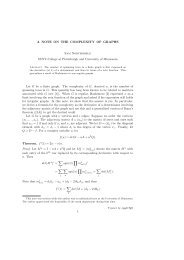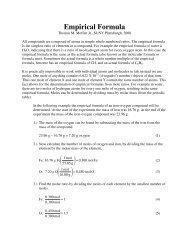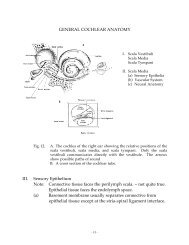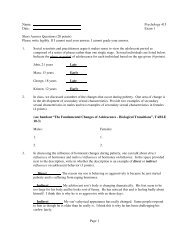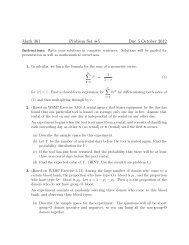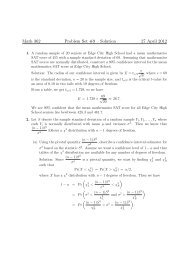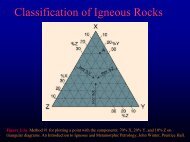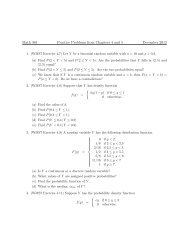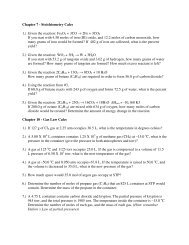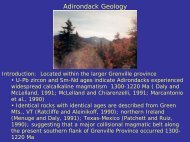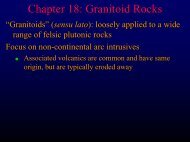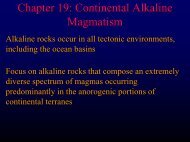Chapter 11 - Diversification of Magmas - Faculty web pages
Chapter 11 - Diversification of Magmas - Faculty web pages
Chapter 11 - Diversification of Magmas - Faculty web pages
Create successful ePaper yourself
Turn your PDF publications into a flip-book with our unique Google optimized e-Paper software.
<strong>Chapter</strong> <strong>11</strong>: <strong>Diversification</strong> <strong>of</strong><br />
<strong>Magmas</strong>
Magmatic Differentiation<br />
<br />
Any process by which a magma is able to<br />
diversify and produce a magma or rock <strong>of</strong><br />
different composition
Magmatic Differentiation<br />
<br />
Two essential processes affect magmatic<br />
differentiation:<br />
1. Creates a compositional difference in one or<br />
more phases (minerals)<br />
2. Segregation or fractionation <strong>of</strong> the chemically<br />
distinct portions
Partial Melting<br />
Separation <strong>of</strong> a partially melted liquid (the melt)<br />
from the solid residue (the residuum)
Eutectic Melting<br />
Eutectic point = the single point where two liquidus<br />
lines meet the solidus line<br />
Represents both T and composition <strong>of</strong> the lowest T melt<br />
M = eutectic point
Eutectic Melting<br />
First melt always = eutectic composition<br />
Major element composition <strong>of</strong> eutectic melt is<br />
constant until one <strong>of</strong> the source mineral phases is<br />
consumed<br />
Once a phase is consumed, the next increment <strong>of</strong> melt<br />
will be different composition (X) and T
Critical Melt Fraction<br />
<br />
Separation <strong>of</strong> a partially melted liquid from the<br />
solid residue requires a critical melt %<br />
<br />
Sufficient melt must be produced to<br />
1. Form a continuous, interconnected film<br />
2. Have enough volume so not all <strong>of</strong> it is<br />
adsorbed to the crystal surfaces
The ability to form an interconnected film is<br />
dependent upon the dihedral angle (θ)(<br />
- a property<br />
<strong>of</strong> the melt<br />
a. θ = dihedral angle <strong>of</strong><br />
melt droplets at<br />
multiple grain<br />
boundaries<br />
b. Low θ = continuous<br />
interconnected<br />
network<br />
c. Higher θ = isolated<br />
melt droplets<br />
Figure <strong>11</strong>-1 Illustration <strong>of</strong> the dihedral angle (θ)(<br />
) <strong>of</strong><br />
melt droplets that typically form at multiple grain<br />
junctions. After Hunter (1987) In I. Parsons (ed.),<br />
Origins <strong>of</strong> Igneous Layering. Reidel, , Dordrecht,<br />
pp. 473-504.
Factors affecting separation <strong>of</strong> melt<br />
Viscosity – high viscosity silicic melts, e.g., rhyolite,<br />
difficult to extract<br />
Critical melt fraction<br />
% <strong>of</strong> melt at which crystal mush (melt-dominated,<br />
fluid suspension) forms<br />
Theoretical calculations with spheres = 26% melt<br />
Irregular shapes and sizes = 30-50% for granitic<br />
compositions
Liquid separation by gravitational effects<br />
Buoyant liquid seeks to rise and escape xstal<br />
residue<br />
1) Filter pressing (compaction) crystal mush<br />
Xstal-liquid liquid system squeezed like a sponge<br />
Liquid migrates from compacted solids
Fractional Crystallization<br />
<br />
<br />
Process by which all xstals formed are removed<br />
from melt<br />
Causes continuously changing magma composition<br />
Dominant mechanism by which most magmas<br />
differentiate
Gravity settling<br />
Differential motion <strong>of</strong> crystals and liquid under<br />
the influence <strong>of</strong> gravity due to their differences in<br />
density<br />
Cumulate texture: mutually touching phenocrysts<br />
embedded in an interstitial matrix which is the<br />
crystallized residual melt
Gravity settling – Ternary Phase Diagram<br />
3 Phases = An (anorthite(<br />
anorthite), Di (diopside(<br />
diopside), and Fo<br />
(forsterite<br />
olivine)<br />
Point a → olivine layer<br />
at base <strong>of</strong> pluton<br />
if olivine sinks first<br />
Next get ol + cpx layer<br />
Last get ol + cpx + plag<br />
layer<br />
Figure 7-2. After Bowen (1915), A. J. Sci., and Morse (1994), Basalts and Phase<br />
Diagrams. Krieger Publishers.
Stoke’s Law – used to quantify crystal settling<br />
velocities<br />
V 2gr 2<br />
( ρ − ρ<br />
s l<br />
=<br />
)<br />
9η<br />
V = the settling velocity (cm/sec)<br />
g = the acceleration due to gravity (980 cm/sec 2 )<br />
r = the radius <strong>of</strong> a spherical particle (cm)<br />
ρ s = the density <strong>of</strong> the solid spherical particle (g/cm 3 )<br />
ρ l = the density <strong>of</strong> the liquid (g/cm 3 )<br />
η = the viscosity <strong>of</strong> the liquid (1 c/cm sec = 1 poise)
Olivine in basalt<br />
Olivine (ρ(<br />
s = 3.3 g/cm 3 , r = 0.1 cm)<br />
Basaltic liquid (ρ(<br />
l = 2.65 g/cm 3 , η = 1000 poise)<br />
V = 2·9802<br />
980·0.10.1 2 (3.3-2.65)/9<br />
2.65)/9·1000 = 0.0013 cm/sec
Rhyolitic melt<br />
η = 10 7 poise and ρ l = 2.3 g/cm 3<br />
<br />
hornblende crystal (ρ(<br />
s = 3.2 g/cm 3 , r = 0.1 cm)<br />
V = 2 x 10 -7 cm/sec, or 6 cm/year<br />
<br />
feldspars (ρ l = 2.7 g/cm 3 )<br />
V = 2 cm/year<br />
= 200 m in the 10 4 years that a stock might take to<br />
cool<br />
If 0.5 cm in radius (1 cm diameter), settle at 0.65<br />
meters/year, or 6.5 km in 10 4 years cooling <strong>of</strong><br />
stock
Stokes’ Law is overly simplified<br />
1. Crystals are not spherical<br />
2. Only basaltic magmas very near their<br />
liquidus temperatures behave as<br />
Newtonian fluids
Mechanisms that facilitate the separation <strong>of</strong> crystals<br />
and liquid<br />
1. Filter Pressing (compaction)– in xstal mushes<br />
that form as cumulates or xstal suspensions
Mechanisms that facilitate the separation <strong>of</strong> crystals<br />
and liquid<br />
2. Flow segregation – motion <strong>of</strong> magma past country rock<br />
walls results in velocity gradient near walls and creates<br />
shear in viscous magma<br />
Shear constricted between<br />
phenocrysts or in contact with<br />
country rock<br />
Force called grain-dispersive<br />
pressure pushes phenocrysts apart<br />
and away from contact<br />
Figures <strong>11</strong>-4 4 and <strong>11</strong>-5 Drever and Johnston (1958). Royal Soc. Edinburgh<br />
Trans., 63, 459-499.<br />
499.
Flow differentiation -<br />
Concentration <strong>of</strong> coarse<br />
phenocrysts toward center <strong>of</strong><br />
dikes and sills
Volatile Transport<br />
- separate vapor phase coexists with magma<br />
1. Vapor released by heating <strong>of</strong> hydrated or carbonated<br />
wall rocks<br />
2. As a volatile-bearing magma rises and pressure is<br />
reduced, magma becomes saturated in the vapor, and a<br />
free vapor phase will be released<br />
Produces hydrothermal effects such as alkali<br />
metasomatism called fenitization
3. . Late-stage fractional crystallization – forms separate<br />
fluid phase<br />
<br />
<br />
<br />
<br />
<br />
Fractional crystallization enriches late melt in<br />
H 2 O, other volatiles, incompatible elements<br />
Saturation point reached<br />
Hydrous vapor phase formed<br />
Produces boiling <strong>of</strong>f <strong>of</strong> H 2 O as magma cools (retrograde<br />
boiling)<br />
Results in<br />
silicate-saturated saturated vapor<br />
vapor-saturated late silicate liquid enriched in volatiles<br />
and incompatible elements
Volatile release increases P - fractures ro<strong>of</strong> rocks <strong>of</strong><br />
magma chamber<br />
<br />
Vapor and melt escape along fractures as dikes<br />
Silicate melt composed <strong>of</strong> quartz and feldspar<br />
forms small dikes <strong>of</strong> aplite<br />
Vapor phase forms pegmatites (coarser-<br />
grained dikes)
Pegmatites: : Concentrate incompatible elements<br />
Complex varied mineralogy with very large unusual<br />
minerals<br />
MacDonald<br />
Pegmatite<br />
Bancr<strong>of</strong>t, Ont.
Hornblende<br />
retrograde boiling<br />
Silver Crater Pegmatite<br />
Bancr<strong>of</strong>t, Ont.<br />
Apatite
8 cm tourmaline crystals<br />
from pegmatite<br />
5 mm gold from a<br />
hydrothermal deposit
Liquid Immiscibility – Italian Salad Dressing<br />
<br />
<br />
<br />
Analogy<br />
Widely accepted as phenomenon in natural<br />
magmas<br />
Extent <strong>of</strong> process in question<br />
Importance in generating large intrusive bodies<br />
questionable
Liquid Immiscibility – Some examples<br />
Late silica-rich immiscible droplets in Fe-rich<br />
tholeiitic basalts<br />
Sulfide-silicate immiscibility in massive sulfide<br />
deposits<br />
Carbonatite-nephelinite<br />
nephelinite systems
Magma Mixing<br />
<br />
End member mixing in a suite <strong>of</strong> rocks,<br />
e.g., basalt and rhyolite magmas<br />
<br />
Variation on composition diagrams<br />
should lie on a straight line between the<br />
two most extreme parental compositions
Comingled Basalt-Rhyolite<br />
Mt. McLoughlin, , Oregon<br />
Figure <strong>11</strong>-8 From Winter (2001) An Introduction to<br />
Igneous and Metamorphic Petrology. Prentice Hall<br />
Basalt pillows accumulating at<br />
the bottom <strong>of</strong> granitic magma<br />
chamber<br />
Vinalhaven Island, Maine
Assimilation<br />
<br />
<br />
Incorporation <strong>of</strong> wall rocks, xenoliths<br />
Assimilation by melting is limited by<br />
the heat available in the magma
Zone melting<br />
<br />
Crystallizing igneous material at the<br />
base equivalent to the amount melted<br />
at the top<br />
Transfer heat by convection<br />
Most likely to occur in large mafic<br />
magmas deep in the crust where<br />
country rocks close to liquidus T
In Situ Differentiation Processes<br />
<br />
<br />
In-situ: crystals don’t sink/move<br />
Typically involves<br />
Diffusion<br />
Convective separation <strong>of</strong> liquid and crystals
The Soret Effect<br />
<br />
<br />
Thermal diffusion = Soret effect<br />
Heavy elements/molecules migrate toward the colder end<br />
and lighter ones to the hotter end <strong>of</strong> the gradient
Thermogravitational diffusion<br />
Stable and persistent stagnant boundary layers occur near the<br />
top and sides <strong>of</strong> magma chambers<br />
Figure <strong>11</strong>-<strong>11</strong>. Schematic section through a rhyolitic magma chamber undergoing convection-aided in-situ differentiation.<br />
After Hildreth (1979). Geol. Soc. Amer. Special Paper, 180, 43-75.
Langmuir Model<br />
<br />
<br />
Thermal gradient at wall and cap produces variation in %<br />
crystallization<br />
Compositional convection produces evolved magmas from<br />
boundary layer to cap<br />
Figure <strong>11</strong>-12<br />
12 Formation <strong>of</strong> boundary layers along<br />
the walls and top <strong>of</strong> a magma chamber. From<br />
Winter (2001) An Introduction to Igneous and<br />
Metamorphic Petrology. Prentice Hall
Detecting and assessing assimilation<br />
Isotopes are generally the best<br />
Continental crust becomes progressively enriched in<br />
87 Sr/ 86 Sr and depleted in 143 Nd/ 144 Nd<br />
Figure 9-13. 9<br />
Estimated<br />
Rb and Sr isotopic<br />
evolution <strong>of</strong> the Earth’s<br />
upper mantle, assuming<br />
a large-scale melting<br />
event producing<br />
granitic-type type continental<br />
rocks at 3.0 Ga b.p After<br />
Wilson (1989). Igneous<br />
Petrogenesis. Unwin<br />
Hyman/Kluwer<br />
Kluwer.
Tectonic-Igneous Associations<br />
<br />
<br />
Associations on a larger scale than the<br />
petrogenetic provinces<br />
Attempt to address global patterns <strong>of</strong> igneous<br />
activity by grouping provinces based upon<br />
similarities in occurrence and genesis
Tectonic-Igneous Associations<br />
Mid-Ocean Ridge Volcanism<br />
Ocean Intra-plate (Island) volcanism<br />
Continental Plateau Basalts<br />
Subduction-related volcanism and plutonism<br />
Island Arcs<br />
Continental Arcs<br />
Granites<br />
Mostly alkaline igneous processes <strong>of</strong> stable<br />
craton interiors<br />
Anorthosite Massifs



